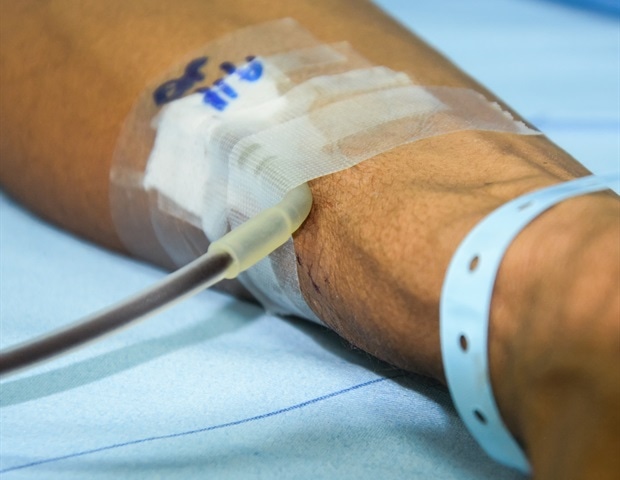Health
New Wearable Device Aims to Detect Postpartum Hemorrhage Early

In an effort to combat the leading cause of maternal death worldwide, researchers at Washington University in St. Louis are developing a wearable device designed to detect postpartum hemorrhage (PPH) early. This condition often arises suddenly during or after childbirth, presenting significant risks to patients when excessive blood loss occurs, sometimes without visible signs.
Postpartum hemorrhage is defined as a loss of at least 1 liter (1,000 milliliters) of blood within 24 hours of delivery. The rapid onset of this condition can leave healthcare teams scrambling for effective interventions, such as blood transfusions or surgical procedures. Current methods for monitoring blood loss, such as visual assessments or counting blood-soaked materials, are often inadequate.
According to Christine O’Brien, an assistant professor of biomedical engineering, the limitations of existing techniques hinder timely responses. “Blood loss is difficult to measure, and normal vital signs like heart rate or blood pressure can remain stable even after losing up to 1,500 milliliters of blood,” she explained. This delay in detection can lead to dire consequences for new mothers.
Innovative Approach to Blood Loss Monitoring
Funded by a $2.8 million grant from the National Heart, Lung, and Blood Institute, part of the National Institutes of Health (NIH), O’Brien’s team intends to create a novel light-based sensor that continuously tracks blood loss by measuring cardiovascular features. This sensor will analyze changes in hemoglobin and blood flow, producing waveforms that reflect the state of a person’s cardiovascular system.
Using advanced statistical methods and machine learning algorithms, the research team aims to identify waveform characteristics that correlate with absolute blood loss. With this technology, a wearable device could provide early warnings of hemorrhage, allowing for timely intervention.
“We’ll be able to have a much clearer signal when someone is hemorrhaging,” O’Brien stated. The device is designed to fit comfortably on a patient’s wrist, making it both accessible and practical for clinical use.
Ensuring Accuracy and Inclusivity
To address potential disparities in sensor accuracy, the research will include tests on animal models with varying skin pigmentation. Previous studies have shown that light-based sensors, such as pulse oximeters, can yield differing results based on skin tone. O’Brien’s team emphasizes that their device aims to ensure consistent and accurate readings across diverse populations.
Additionally, the team plans to test the device on human subjects with varying levels of hemodilution, which occurs when hemoglobin concentration is diluted by other fluids. This thorough testing will help ensure the device can accurately monitor blood loss under different circumstances.
While developing this technology, O’Brien highlights the importance of preventing postpartum hemorrhage altogether. Early detection can facilitate simple, low-cost interventions such as uterine massage, which can effectively control bleeding.
“The ability to intervene early can significantly reduce the risk of severe complications,” she noted. Less blood loss means that healthcare facilities, especially those with limited resources, may not face overwhelming emergencies requiring immediate transfusions or surgical interventions.
As the project progresses, the hope is that this innovative wearable device will ultimately save lives by providing healthcare professionals with the tools they need to respond swiftly to postpartum hemorrhage. The urgency of this research reflects a commitment to improving maternal health outcomes globally, ensuring that new mothers receive the care they need in critical moments.
-

 Health3 months ago
Health3 months agoNeurologist Warns Excessive Use of Supplements Can Harm Brain
-

 Health3 months ago
Health3 months agoFiona Phillips’ Husband Shares Heartfelt Update on Her Alzheimer’s Journey
-

 Science1 month ago
Science1 month agoBrian Cox Addresses Claims of Alien Probe in 3I/ATLAS Discovery
-

 Science1 month ago
Science1 month agoNASA Investigates Unusual Comet 3I/ATLAS; New Findings Emerge
-

 Science4 weeks ago
Science4 weeks agoScientists Examine 3I/ATLAS: Alien Artifact or Cosmic Oddity?
-

 Entertainment4 months ago
Entertainment4 months agoKerry Katona Discusses Future Baby Plans and Brian McFadden’s Wedding
-

 Science4 weeks ago
Science4 weeks agoNASA Investigates Speedy Object 3I/ATLAS, Sparking Speculation
-

 Entertainment4 months ago
Entertainment4 months agoEmmerdale Faces Tension as Dylan and April’s Lives Hang in the Balance
-

 World3 months ago
World3 months agoCole Palmer’s Cryptic Message to Kobbie Mainoo Following Loan Talks
-

 Science4 weeks ago
Science4 weeks agoNASA Scientists Explore Origins of 3I/ATLAS, a Fast-Moving Visitor
-

 Entertainment4 months ago
Entertainment4 months agoLove Island Star Toni Laite’s Mother Expresses Disappointment Over Coupling Decision
-

 Entertainment3 months ago
Entertainment3 months agoMajor Cast Changes at Coronation Street: Exits and Returns in 2025









